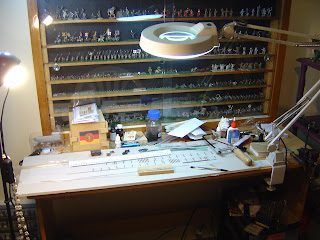Posting a wee bit late today. The lady of the house is at home ill, so guess who has to run around catering....
Anyhoo, today I'm having a closer look at the assembly of the laser cut J sheep wagon, as its not an easy prospect. Since I've assembled 2 now I'm appointing myself the world expert until someone else does 3 :v).
First up this time around I decided to paint as I went as some areas are impossible to paint after assembly. The first tricky job is to place the horizontal slats in place. this is easy enough using a door as the template. However, what it doesn't day in the current set of instructions is anything about the horizontal position.
(sorry about the pictures, I had plenty of light, but the camera didn't seem to think so)
As you can see here (sort of), the planking should sit level with the outside of the last upright post, with no overlap. The inside end piece will eventually slot in here.

Here I've painted and weathered the floor by
drybrushing with my Iraqi sand colour (and a dust with a wee bit of white to cap it off). I wasn't happy with the first one in that I couldn't get into the crevasses that appear when the cross beams are added.
Now we move to the hardest bit of the whole thing (putting the wires in are a doddle compared to this) the easiest way I've found to do this is as follows

First join the 2 ends to a side as it says in the instructions. They don't have to be particularly square at the moment, just well glued.

Next we glue in the inner ends, making sure that the details are facing outwards. These should fit into the slots we left earlier...
Adding the floors is the most fiddly bit. I start of by gluing the lower floor ( the one without the slat detail) into position just by applying
PVA to the indentations on the sides. DO NOT attempt to glue the ends to the floor as it could
really bit you in the butt later, leading to contributions the the swear jar and
disapproving looks from the local vicar. The floor should sit down on the bottom horizontal frame post.

The floor can just sit hanging down a bit.
PVA is reasonably
flexible for an hour or so after it 'sticks' but before it 'sets'
The upper floor can now be fitted in, again just gluing the
indentations into the side posts. let it set a bit while standing in
vertical.

The second side is then fitted into place. you don't need 4 arms, just a sharpish tool to
maneuver everything into place
until it clicks in. Again just apply glue into the indentations on the sides of the floors.

And there you have it, a semi complete wagon only requiring doors and bracing to complete it (oh, and a chassis as well...)
Finally, here is a line up of the various attempts to model J sheep wagons.

The first one is a resin cast version that I made 20 years ago. This was quite
impressive for its time casting wise, but somehow muggins got the dimensions wrong and it was too big. The second is the Mk II version features a few months back, with some detail to be added (and the doors corrected). Finally we have the
finished product, which scaled up would not look out of place on an S scale layout.


















































